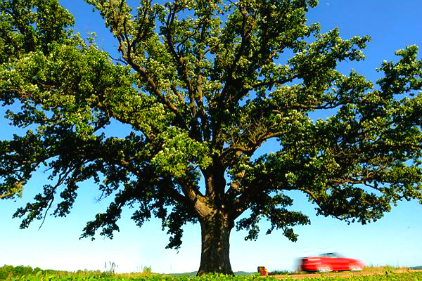My favorite shade trees of all time are the oaks. Planted and wat-
ered properly, young trees will grow fast and can dramatically
enhance our landscapes.
Apart from their beauty, there is a practical consideration too. If
you plant them in the right place, shade trees will cool off the air
around your home and help offset costly utility bills.
We have two native Texas oaks that are considered evergreen: the
live oak and the Mexican white oak. Both hold their foliage through-
out the winter months, but then shed their leaves around the end
of February-early March. Spring growth follows in 2 to 3 weeks.
Evergreen oaks are also highly effective as windbreaks and privacy
screens. In addition, when planted on the east, south, and west sides
of a house, they’ll provide you with winter shade.
On the Texas Superstars list and one of my favorite Texas native
shade trees is the Chinquapin oak.
What makes this deciduous shade tree so wonderful is its uncomm-
on appearance. The leaves can be 6 to 8 inches long and 4 inches
wide. The leaf color is deep green on top with a whitish underside.
Unlike the smooth leaf of the live oak, the Chinquapin’s leaves are
toothed or serrated. Sometimes we call it the ‘Saw Tooth Oak.’
This magnificent shade tree fits so well with the central Texas
climate. It loves the heat and does well in our alkaline soil. It’s
very drought resistant and has few problems with insects and dis-
ease pests.
Plant your Chinquapin on a well-drained location in full sun or
just a little shade. With infrequent, deep waterings, this beauty can
grow moderately fast, reaching an average height of 40 feet with
an equal spread.
Chinquapin’s fall color is yellow to bronze, making it at top choice
for fall color in the landscape. Their small acorns are loved by birds,
squirrels, deer, and wild turkeys.
For fall color, the Shumards (commonly known as the Texas red
oak) are hard to beat. They carry their brilliant red/orange fall
colors throughout November and December, and late trees can
hold these colors even into January.
The stately Bur oak sheds its big leaves without fall color change.
However during the winter months you can enjoy the stark beauty
of their bark and branching structure..
Considered slow growing, the oaks have often been overlooked
by homeowners and property developers in their quest for fast
growing shade trees. People have often made the mistake of choos-
ing soft-wooded trees like Arizona ash, only to find a few years
later that they are short lived and expensive to remove.
The oaks, however, when planted properly and watered on a reg-
ular basis, can grow as much as 3 feet a year in height and width.
That’s fifteen feet in five years. Now that’s shade. Happy Garden-
ing Everyone!❦






